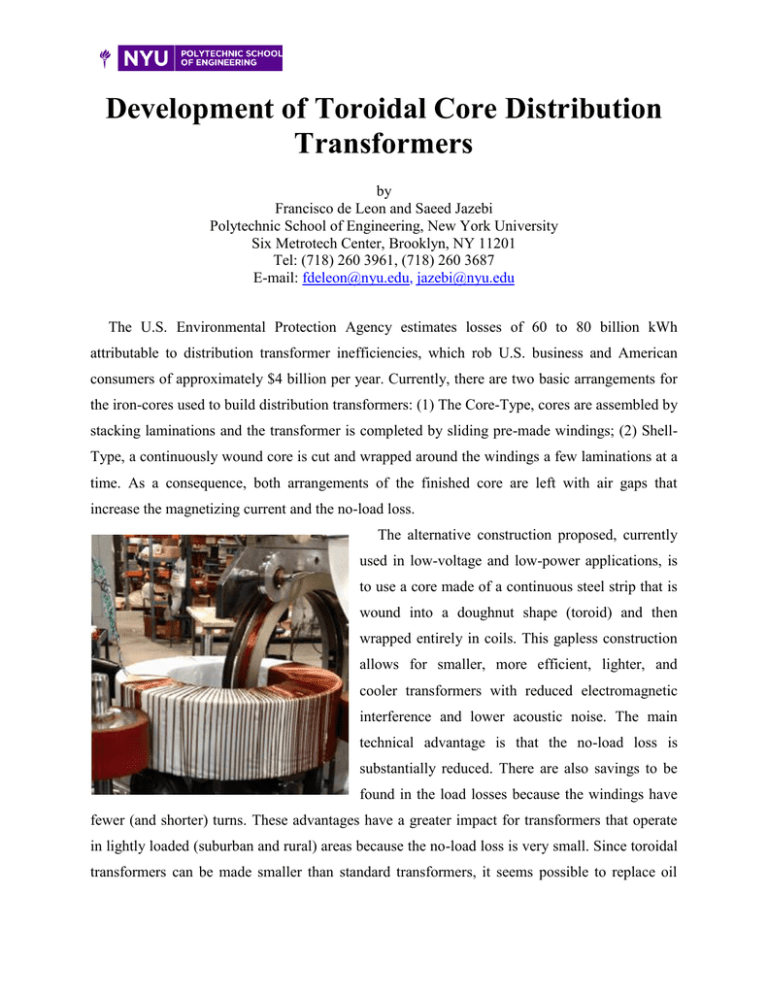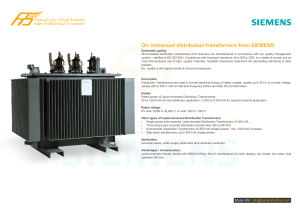Development of Toroidal Core Distribution Transformers
advertisement

Development of Toroidal Core Distribution Transformers by Francisco de Leon and Saeed Jazebi Polytechnic School of Engineering, New York University Six Metrotech Center, Brooklyn, NY 11201 Tel: (718) 260 3961, (718) 260 3687 E-mail: fdeleon@nyu.edu, jazebi@nyu.edu The U.S. Environmental Protection Agency estimates losses of 60 to 80 billion kWh attributable to distribution transformer inefficiencies, which rob U.S. business and American consumers of approximately $4 billion per year. Currently, there are two basic arrangements for the iron-cores used to build distribution transformers: (1) The Core-Type, cores are assembled by stacking laminations and the transformer is completed by sliding pre-made windings; (2) ShellType, a continuously wound core is cut and wrapped around the windings a few laminations at a time. As a consequence, both arrangements of the finished core are left with air gaps that increase the magnetizing current and the no-load loss. The alternative construction proposed, currently used in low-voltage and low-power applications, is to use a core made of a continuous steel strip that is wound into a doughnut shape (toroid) and then wrapped entirely in coils. This gapless construction allows for smaller, more efficient, lighter, and cooler transformers with reduced electromagnetic interference and lower acoustic noise. The main technical advantage is that the no-load loss is substantially reduced. There are also savings to be found in the load losses because the windings have fewer (and shorter) turns. These advantages have a greater impact for transformers that operate in lightly loaded (suburban and rural) areas because the no-load loss is very small. Since toroidal transformers can be made smaller than standard transformers, it seems possible to replace oil immersed overhead transformers with dry toroidal units, reducing the potential for violent faults in addition to the environmental benefits of avoiding the use of oil. Toroidal transformers are not currently in use in distribution systems. Given the lack of experience with toroidal design at medium and high voltages, efforts has been made to develop the technology to pass the impulse tests, study the thermal performance and produce a sound mechanical design. All the design has been done at the School of Engineering, New York University, by graduate students (M.S. and Ph.D.) and post-doctoral fellows under the guidance of Prof. Francisco de Leon. The details of the solutions have been presented in the following patent and set of papers: 1. F. de Leon, “Electrostatic Shielding for Transformers”, U.S. Patents, 2013. 2. F. de León, S. Purushothaman, and L. Qaseer, “Leakage Inductance Design of Toroidal Transformers by Sector Winding”, IEEE Transactions on Power Electronics, vol. 29, no. 1, Jan. 2014, pp. 473-480. 3. S. Purushothaman and F. de León, “Heat Transfer Model for Toroidal Transformers”, Transactions on Power Delivery, vol. 27, no. 2, Apr. 2012, pp. 813-820. 4. Hernández, F. de León, and P. Gómez, “Design Formulas for the Leakage Inductance of Toroidal Distribution Transformers”, IEEE Transactions on Power Delivery, vol. 26, no. 4, Oct. 2011, pp. 2197-2204. 5. P. Gómez, F. de León, and I. Hernández, “Impulse Response Analysis of Toroidal Core Distribution Transformers for Dielectric Design”, IEEE Transactions on Power Delivery, vol. 26, no. 2, Apr. 2011, pp. 1231-1238. The development of toroidal core transformers for medium-voltage applications is a project supported by the US Department of Energy under Grant DEOE0000072. The idea is to benefit from the virtues of the toroidal construction to manufacture, test and install toroidal transformers suitable for power distribution applications. At this time (April 2014) we have built two prototypes, one of 25 kVA and another one of 50 kVA. The 25 kVA transformer has been successfully tested and passed the impulse tests at Kema high-voltage laboratory. The electrical characteristics of the transformers are similar to the oil-immersed pole mounted transformers currently in use by many utilities, but with higher efficiency. The performance of these transformers is not typical; for example the 50 kVA transformer has a no-load loss of only 45 W. A standard transformer has a no-load loss between 90 and 240 W. Thus, even the finest transformer built today with standard technology has double the amount of no-load loss than the prototype toroidal transformer. The 50 kVA transformer is designed and built according to the Con Edison purchase requirements. It is intended to install this transformer in operation on an overhead system to allow for the observation of the unit under real life operation. It is estimated that, in the mass production phase, the transformer cost will be very close to standard oilimmersed transformers. However, because of the higher efficiency, the operating cost will be almost half of the standard transformers. Its dry-type inherent makes it environmental friendly, while it is not subjected to catastrophic explosions. New York University Serial No. 20130615-001-00000002 kVA 25 Hz 60 Ph. 1 %Z 1.0 H.V. 7.62 kV L.V. 120/240 V H.V. Amps 3.28 L.V. Amps 104 H.V. BIL 95 kV L.V. BIL 30 kV Conductor Copper °C Rise 60 Total Wt. 252 kg Type Dry-type Class GA H1 Tank Fig. 1. Nameplate information of the 25 kVA transformer. X1 Voltage X0 120 V X2 240 V Terminals X1-X0, X0-X2 X1-X2 New York University Serial No. 20140422-001-00000003 kVA 50 Hz 60 Ph. 1 %Z 0.61 H.V. 7.62 kV L.V. 120/240 V H.V. Amps 6.56 L.V. Amps 208 H.V. BIL 95 kV L.V. BIL 30 kV Conductor Copper °C Rise 67 Total Wt. 426 kg Type Dry-type Class GA H1 X1 Voltage X0 120 V X2 240 V Terminals X1-X0, X0-X2 X1-X2 Tank Fig. 2. Nameplate information of the 50 kVA transformer. 25 kVA Performance Parameters Efficiency [%] Total losses [W] Diameter [in] Height [in] Temperature of hot spot [C] No load loss [W] Magnetizing current [mA] Measured 99.2* 199 24 20 82 28 14 * DOE (efficiency final rule): Dry type: 98 % Liquid immersed: 98.91 % 50 kVA Performance Parameters Efficiency [%] Total losses [W] Diameter [in] Height [in] Temperature of hot spot [C] No load loss [W] Magnetizing current [mA] * DOE (efficiency final rule): Dry type: 98.3% Liquid immersed: 99.08 % Design 99.28* 362 27 24 99 45 24

